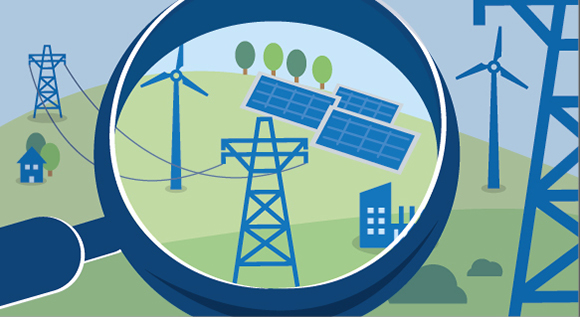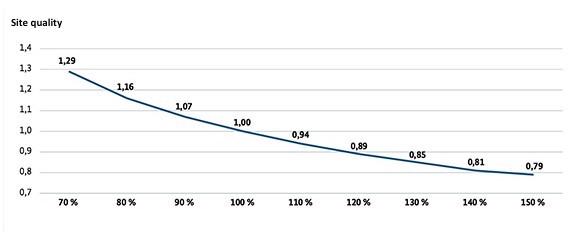What is actually the reference yield model?
How can onshore wind energy be funded without blowing away the motivation to build efficient installations at less windy sites? By putting equivalent competitive conditions for funding in place from the Baltic in the north to the Zugspitze in the south. And that is what the reference yield model is designed to do.
 © BMWi
© BMWiThe goal: increasing the amount of wind energy in Germany
If new wind turbines were only built in places where the wind is strongest and operators can therefore expect the highest yields, the new build would mainly take place on the northern coasts, where wind power is traditionally strong (cf. direkt finds diagram). Even more wind power would have to be transported across long distances to the consumers, and even more powerlines would be needed. That simply can’t be the right way forward: the time-consuming and expensive expansion of the electricity highways from the north to the south is already the Achilles heel of the energy transition. Spreading the wind turbines across a large area also offers clear advantages for the energy industry: it means that the feed-in of wind power into the grid is more constant, and makes it easier to predict the future feed-in.
So it makes good sense to expand wind power close to the consumers. As the funding of renewable energy is brought closer to the market, and competitive auctions are introduced, all the stakeholders need to have a fair chance, a playing field that is as level as possible. The question is how to make this happen. After all, the principle is that funding goes to those who bid least. This means that plant operators from high-wind regions would truly have a favourable wind behind their bids, since they can get by with less assistance. It’s rather like a farmer with highly fertile soil who can harvest a particularly large quantity of potatoes – his fixed costs are really low. And farmers working with poorer soil can’t compete. If the funding can only go to the bidder who by his very nature is able to calculate lower costs, one of the farmers would have an unassailable advantage right from the outset.
The tool: comparability through the “reference site”
No matter whether they are farming the fields or the wind: if it is to be possible to compare who is really most efficient and producing most cheaply, it is necessary to level the field – at least in theory. In the case of wind power expansion, the reference yield model does just that. It may have a rather awkward name, but it not only makes sites with varying wind yields comparable, but also the estimated amounts of funding per kilowatt-hour which wind farm operators bid to compete in the new auctions.
What happens is that a “reference site” with a specific amount of wind is defined and designated as “100 per cent”. All the other sites where wind turbines are being planned can now be compared against this benchmark. At an 80 per cent site, for example, there is 20 per cent less wind than at the reference site, and at a 120 per cent site there is 20 per cent more.
Wind farm operators bidding for funding start by citing the sum they have calculated which will enable them to run a wind farm at this reference site. So their bid does not refer to their actual site, but is converted to answer the question: How high would the funding have to be if my installation were located at the reference site?
The effect: the harder the wind, the lower the funding per kilowatt-hour
The funding they actually get is the price they have bid, adjusted up or down by a correction factor. It is higher at sites with little wind, and lower at windy sites. In plain language, this means that where there is a particularly high amount of wind and the yields are high, there will be a bit less cash for each kilowatt-hour fed into the grid. Where the wind is weaker, the remuneration is higher.
The benefits of the reference yield model are obvious: projects can be compared independently of the actual wind conditions. And this needs to happen, because the funding only goes to the cheapest bids. So competition can take place between projects at different sites, and there is an incentive to build the most efficient installations.
The benchmark: the key elements paper sets out the figures
The revised paper containing principles for the reform of the Renewable Energy Sources Act (only in German) contains the figures for the future wind power funding, ready for adoption in the course of this year. The new reference site is defined as a site with a wind speed of 6.45 meters per second at a height of 100 meters; the higher wind speeds for taller turbines are calculated using a widely accepted model. The aim is to encourage investors to build particularly high, innovative turbines which can feed in a lot of wind energy. Last year, the new wind energy installations in Germany already had an average hub height of 123 meters.
Also, the paper contains an overview of site quality and the correction factors to be used in setting the funding rate. The quality of a site is stipulated by independent, certified experts. As in the case of other renewable energy technologies, the funding is paid out over a 20-year period, and site reviews are to take place after five, ten and fifteen years.
 The diagram shows the correction factors used for different site qualities in the future. © BMWi
The diagram shows the correction factors used for different site qualities in the future. © BMWi

